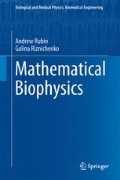Abstract
The main property of nerve cells is their ability to conduct nerve pulses—electrical waves spreading along the nerve fiber. The conduction property is based on the fact that the elementary volume of a membrane is a local active element possessing the ability to amplify an incoming electrical signal. Nerve pulse propagation is one of the most striking examples of autowave processes in living systems. In the middle of the nineteenth century it was found that nerve pulses in frogs spread without visible damping over rather large distances, up to 10 cm (Helmholtz 1850). German scientist Hermann Ludwig Ferdinand von Helmholtz (1821–1894) was the first scientist to measure the speed of excitation spread in a nerve—in experiments on frogs in 1850, and in 1867–1870 together with Russian scientist Nikolai Bakst—in a human being and determined the conditions of the threshold electrical stimulation of nerve fibers. Helmholtz also made the first experimental attempt to determine the rhythm of pulses sent by the brain to muscles and determined the period of muscle response to sensory irritation.
Access this chapter
Tax calculation will be finalised at checkout
Purchases are for personal use only
References
Aliev RR, Chailakhyan LM (2005) Study of the effect of acetylcholine on intracellular homeostasis of true pacemaker cells of rabbit sinus node using computer simulation. Dokl Biochem Biophys 402(1):236–239
Balakhovskii IS (1965) Some regimes of exitation movement in ideal excitable tissue. Biofizika 10(6):1063–1067 (Rus)
FitzHugh R (1961) Impulses and physiological states in theoretical model of nerve membrane. Biophys J 1(6):445–466
Gelfand IM, Gurfinkel VS, Kots IM, Tsetlin ML, Shik ML (1963) On synchronization of motor units and its connection with the model representation. Biofizika 8:475–487 (Rus)
Gelfand IM, Gurfincel VC, Tsetlin ML et al (1966) Some aspects of movement research. In: Models of structural and functional organization of some biological systems. Nauka, Moscow (Rus)
Helmholtz H (1850) Messungen über den zeitlichen Verlauf der Zuckung animalischer Muskeln und die Fortpflanzungsgeschwindigkeit der Reizung in den Nerven. Archiv für Anatomie, Physiologie und wissenschaftliche Medicin 17:176–364
Hodgkin AL, Huxley AF (1952) A quantitative description of membrane current and its application to conduction and excitation in nerve. J Physiol 117(4):500–544
Ivanitskii GR, Krinskii VI, Celkov EE (1978) Mathematical biophysics of the cell. Nauka, Moscow (Rus)
Kovaleva NA, Loskutov AY (2004) Stabilization of chaotic processes induced by diffusion. Dokl RAS 396(1):68–70
Krinskii VI, Fomin SV, Kholopov AV (1967) Critical mass during fibrillation. Biofizika 12(5):908–914
Loskutov AY, Mikchailov AS (2007) Bases of the complex systems theory. ICS-RCD, Moscow-Izhevsk (Rus)
Mazurov ME (2008) Identification of mathematical models of nonlinear dynamical systems. ICS-RCD, Moscow-Izhevsk (Rus)
McAllister RE, Noble D, Tsien RW (1975) Reconstruction of the electrical activity of cardiac Purkinje fibres. J Physiol 251(1):1–59
Murray JD (1993) Mathematical biology. Springer, Berlin
Nagumo J, Arimoto S, Yoshizawa S (1962) An active pulse transmission line simulating nerve axon. Proc IRE 50(10):2061–2071
Noble D (1962) A modification of the Hodgkin-Huxley equations applicable to Purkinje fiber action and pacemaker potentials. J Physiol 160(2):317–352
Plant RE (1978) The effect of calcium++ on bursting neurons. A modeling study. Biophys J 21(3):217–237
Plant RE (1981) Bifurcation and resonance in a model for bursting nerve cells. J Math Biol 11(1):15–32
Rinzel J (1981) Models in neurobiology. In: Enns RH, Jones BL, Miura RM, Rangnekar SS (eds) Nonlinear phenomena in physics and biology. Plenum, New York
Wiener N, Rosenblueth A (1946) The mathematical formulation of the problem of conduction of impulses in a network of connected excitable elements, specifically in cardiac muscle. Arch Inst Cardiol Mex 16:205–265
Author information
Authors and Affiliations
Rights and permissions
Copyright information
© 2014 Springer Science+Business Media New York
About this chapter
Cite this chapter
Rubin, A., Riznichenko, G. (2014). Autowave Processes , Nerve Pulse Propagation , and Heart Activity . In: Mathematical Biophysics. Biological and Medical Physics, Biomedical Engineering. Springer, Boston, MA. https://doi.org/10.1007/978-1-4614-8702-9_7
Download citation
DOI: https://doi.org/10.1007/978-1-4614-8702-9_7
Published:
Publisher Name: Springer, Boston, MA
Print ISBN: 978-1-4614-8701-2
Online ISBN: 978-1-4614-8702-9
eBook Packages: Physics and AstronomyPhysics and Astronomy (R0)

